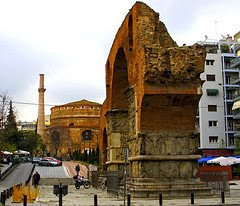The Arch of Galerius and the Rotunda are neighboring early 4th-century monuments in the city of Thessaloniki, in the region of Central Macedonia in northern Greece. The Rotunda is also known as the Church of Agios Georgios or (in English) the Rotunda of St. George.
History : The 4th-century Roman Emperor Galerius commissioned these two structures as elements of an imperial precinct linked to his Thessaloniki palace. Archeologists have found substantial remains of the palace to the southwest. These three monumental structures were connected by a road that ran through the arch, which rose above the major east-west road of the city. The Rotunda was a massive circular structure with a masonry core that had an oculus like the Pantheon in Rome. It has gone through multiple periods of use and modification as a polytheist temple, a Christian basilica, a Muslim mosque, and again a Christian church.
Location and description of the Arch: Arch of Galerius, stands on what is now Egnatia & Dimitrios Gounari Street. The arch was built in 298 to 299 AD and dedicated in 303 AD to celebrate the victory of the tetrarch Galerius over the Sassanid Persians and capture of their capital Ctesiphon in 298. The structure was an octopylon (eight-pillared gateway) forming a triple arch that was built of a rubble masonry core faced first with brick and then with marble panels with sculptural relief. What we see of the triumphal arch today is not its complete original form. The fourth pier of the arch, which would have risen out of the road surface of the modern Egnatia, is missing.
Christoforidou Stella & Xalatsi Ioanna



